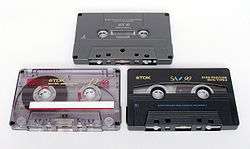Lo-fi music
| Lo-fi | |
|---|---|
 Cassettes of varying tape quality and length | |
| Etymology | Low fidelity |
| Stylistic origins | |
| Cultural origins | 1960s–80s |
| Other topics | |
Lo-fi music (from the term "low fidelity") is lower quality of sound recordings than the usual standard for modern music. The term was adopted in late 1986 by WFMU DJ William Berger, who dedicated a weekly half-hour segment of his program to home recorded music under the name Lo-Fi.[1]
The music also refers to a movement which grew primarily from American underground music scenes in the early 1980s. Associated artists include Sebadoh, Pavement, Liz Phair, and Beck.[2]
Origins
AllMusic writes: "Throughout rock & roll's history, recordings were made cheaply and quickly, often on substandard equipment. In that sense, the earliest rock & roll records, most of the garage rock of the '60s, and much of the punk rock of the late '70s could be tagged as Lo-Fi."[2] The Beach Boys' albums Smiley Smile (1967), Wild Honey (1967), and Friends (1968) were a trilogy of lo-fi albums recorded mostly in Brian Wilson's makeshift home studio; the albums were later referred to as components of his "Bedroom Tapes".[3] JW Farquhar's home-recorded 1973 album The Formal Female is considered an early forerunner to lo-fi artists such as R. Stevie Moore and Jandek.[4]
See also
References
- ↑ Berger, William. "Shit From an Old Cardboard Box, incl. Uncle Wiggly Tour Diary". WFMU's Beware of the Blog. Retrieved 2014-09-19.
- 1 2 "Lo-Fi". AllMusic.
- ↑ Chidester, Brian (March 7, 2014). "Busy Doin' Somethin': Uncovering Brian Wilson's Lost Bedroom Tapes". Paste. Retrieved December 11, 2014.
- ↑ Raggett, Ned. "JW Farquhar - The Formal Female". Allmusic. Retrieved February 22, 2015.
Further reading
- Spencer, Amy (2005). DIY: The Rise of Lo-fi Culture. Marion Boyars. ISBN 978-0-7145-3105-2.